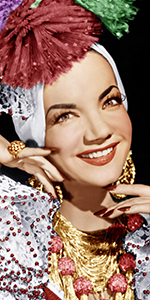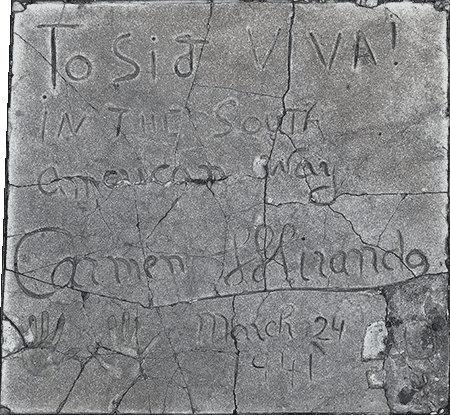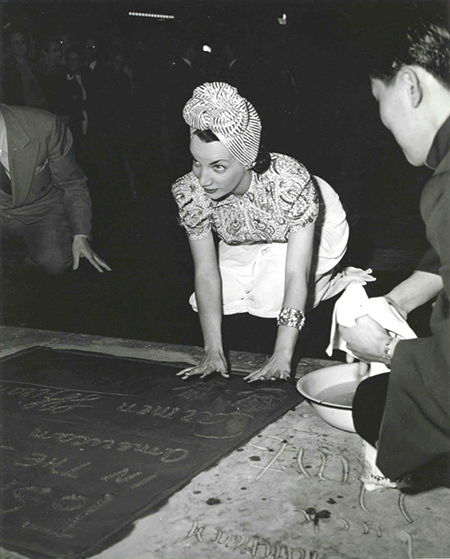 |
 |
 |
 |
 |
| Carmen Miranda, unknown date. |
| |
|
 |
|
 |
| |
| |
|
|
| Carmen Miranda |
 |
| Forecourt Ceremony held on Monday, March 24, 1941 |
| |
Born: Maria do Carmo Miranda da Cunha, February 9, 1909, in Marco de Canaveses, Portugal
Age at the time of the ceremony: 32
Died: August 5, 1955, in Beverly Hills, California, age 46 |
| |
Carmen Miranda became one of the first Latin entertainers to make the big time in America, scoring hits in film musicals, recordings and appearing on radio. With her bright and sunny personality, exotic dancing and her trademark hats, she charmed veiwers and listeners with her outrageous accent and use of English. She died tragically young.
Being the second daughter of a man who emmigrated to Brazil after she was born, Miranda's sister and mother were brought over by her father, who had settled in Rio de Janeiro and had opened a barber shop. Her parents had four more children after thier move.
Named for the title character in Bizet's opera Carmen, the young girl took up singing at an early age. With her mother's encouragement, she auditioned for a radio program, but her father strongly disapproved. At 14, Carmen went to work in a tie shop, where she eventually began selling hats she had created — something which would become her showbiz trademark.
Working with musician Josué de Barros, Carmen recorded her first samba recording in 1929: Não vá Simbora. Her second recording sold so well that she signed a contract with RCA Victor in 1930. In 1933, she became the first singer to be given a contract to sing for a Brazilian radio station, first with Rádio Mayrink Veiga, then, with Radio Tulpi. With a 1938 recording contract with Odeon, she became the highest paid singer in Brazil.
Carmen Miranda dabbled in Brazilian musical films, most of which delt with Carnaval life, such as A Voz do Carnaval (released in March 1933). Her number was placed as the finale to the film Hello, Hello, Brazil! (released in 1935), while she was given an acting role and two numbers in Estudantes (released in July 1935). She was such a big star that her image graced the poster for Alo Alo Carnaval (released in January 1936), which was a lavish all-star musical with samba performers — Miranda got top billing.
Although she became famous for her colorful fruit-hats, she first sported one in the film Banana-da-Terra (released in February 1939), to imitate the garb of the poor women of Bahia. Lee Schubert caught Miranda's act at a Rio nightclub and offered her an eight-week contract to appear on Broadway in The Streets of Paris in 1939. Schubert didn't want to hire Miranda's backup band, Bando da Lua, but she dug in her heels. Brazilian president Getúlio Vargas offered to pay for the band's transport, where they all scored a huge success in New York, with Carmen Miranda becoming a media darling. Hollywood came calling.
She signed up with 20th Century-Fox, and shot her part in Down Argentine Way (which played the Chinese in October 1940) while she was working clubs in New York City, while the rest of the picture was shot in Los Angeles. Her next film was That Night in Rio (played the Chinese in April 1941). The following week, Carmen Miranda actually appeared at the Chinese with her band as the main attraction (with Topper Returns as the B-picture), in hopes that the theatre might prove to be a live-music venue again, but the gross wasn't so much more than what her films pulled, so that was that. She was back on Broadway in December, 1941 for Sons o' Fun, which played until her Schubert contract ran out in June 1942.
During World War II, Miranda's films played an important role in encouraging Americans to consider South American countries as friends and allies. This placed Miranda in a difficult bind; some groups in Brazil began to resent what they saw as her selling out, and playing a Latina ding-dong. Ravenged in the Brazilian press, this reaction to her work hurt her deeply.
But the heavily escapist nature of the Fox musicals became a tonic to war-weary America, with all of the Carmen Miranda Technicolor musicals making pots of money: Week-End in Havana (which played the Chinese in October 1941), Springtime in the Rockies (played the Chinese in October 1942), The Gang's All Here (played in December 1943), Four Jills in a Jeep (played in May 1944), Greenwich Village (played in August 1944), and Something for the Boys (played in November 1944).
After the war, America's interest in Latin America began to wane, and with it, Miranda's headliner status. She was given supporting roles in a pair of low-budget pictures, Doll Face (which played the Chinese in March 1945), and If I'm Lucky (played the Chinese in September 1946).
Her Fox contract ended at the beginning of 1946. She made Copacabana with Groucho Marx (released in May 1947) at United Artists, then did two films at Metro-Goldwyn-Mayer: A Date with Judy (released in July 1948), and Nancy Goes to Rio (released in March 1950). Her last film was the Dean Martin and Jerry Lewis picture Scared Stiff (released in April 1953), for Paramount.
In early 1953, Miranda performed a tour of Europe, but later collapsed onstage while on tour in Cincinnati. Hospitalized for depression, she eventually spent time with her family in Brazil before attempting a comeback to the US, where she performed at the Frontier Hotel in Las Vegas, and also in Havana Cuba. While rehearsing for The Jimmy Durante Show, Miranda complained of feeling unwell. Although Durante offered to find a replacement, she finished her number. After a wrap party at her home, Miranda suffered a fatal heart attack. She was 46. |
|
|
|
|
| |
 |
 |
| Grauman's Chinese Theatre, Hollywood, California. Douglas Fairbanks Forecourt block. Executed by Jean Klossner (?), Monday, March 24, 1941. 39 x 38 inches overall. |
 |
 |
 |
| Grauman's Chinese Theatre, Hollywood, California. Carmen Miranda Forecourt ceremony, Monday, March 24, 1941. Carmen Miranda looks up at photographers while placing her hands in the cement. |
|
|